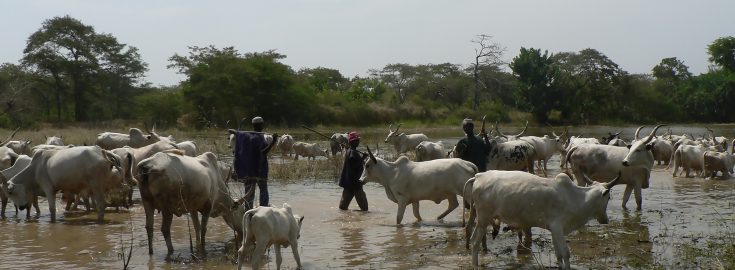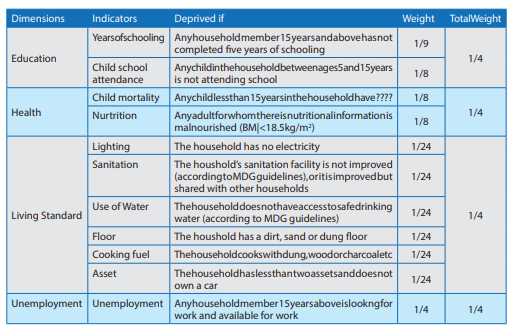
Search
- National MPI
- Global MPI 2021 Country Briefing
- Joined MPPN: 2013
- Dimensions Magazine Articles
National MPI
Nigeria MPI (2022)
The Nigeria Multidimensional Poverty Index (2022) was launched in November 2022. It is built from 15 indicators grouped within four dimensions health, education, living standards, and work and shocks. A household is considered poor if they are deprived in more than one dimension, or the equivalent share (26%) of the weighted indicators measured in the MPI.
The Nigeria MPI (2022) is reported with a linked child MPI which provides an additional focus on child poverty in Nigeria. This introduces a fifth dimension of child survival and development to assess poverty among children under 5. The eight indicators are: severe undernutrition, immunisation, supplement, breast feeding, childcare, child engagement, playground, and birth attendance. A child under 5 is multidimensionally poor in the Child MPI if they are deprived in at least 21% of the indicators—that is, in one dimension plus one indicator.
The Nigeria MPI (2022) expanded on the 2018 MPI to cover additional key deprivations and national priorities. Security shocks have been added to the work dimension. Food security and time to healthcare replaced child mortality because child mortality was very low. School lag has been added to education as a proxy for quality, and water reliability to living standards, while the dimension of work and shocks now includes underemployment and security shocks.
The Nigeria MPI (2022) is the first multidimensional poverty survey for Nigeria to be representative at the senatorial district level. The sample was designed to be representative across 109 senatorial districts, 36 States and FCT Abuja, and was guided by the official population projections published by the National Population Commission of Nigeria.
The Nigeria MPI (2022) was constructed by the National Bureau of Statistics under government leadership. The measure was constructed with technical assistance from the Oxford Poverty and Human Development Initiative at the University of Oxford. The process was supported by the United Nations Development Programme (UNDP) and the United Nations Children’s Fund (UNICEF), the UK Government’s Foreign, Commonwealth and Development Office (FCDO), and Global Affairs Canada.
Source of data: The Nigeria MPI (2022) Survey was undertaken between November 2021 and February 2022 and designed to cover 36 states, FCT Abuja, and 109 Senatorial Districts. Formal displacement camps, military camps, prisons, hospitals, and other such institutions could not be included in the sample. Due to security concerns, 14 of 27 LGAs across all senatorial districts within Borno State could not be visited by enumerators. As a result, the sample is representative for all senatorial districts and States except Borno.
Download the Nigeria Multidimensional Poverty Index (2022)
Visit National Bureau of Statistics – Download
National MPI (2018)
In 2018, UNDP Nigeria in collaboration with the National Bureau of Statistics (NBS) in a study commissioned as part of the production of the Nigeria – Human Development Report has undertaken an official computation of the MPI at the sub-national level. The Nigerian MPI is composed of four dimensions made up of eleven indicators. Each dimension and each indicator of each dimension were assigned equal weights as shown below:
Source: Nigeria – Human Development Report (page 79).
Source of data: 2017 Human Development Indices Survey. The survey covered households in both urban and rural areas in all the 36 states of the Federation and the Federal Capital Territory (FCT), Abuja using the Enumeration Areas (EAs), which established through the National Integrated Survey of Households (NISH). A total sample 120 Enumeration Areas (EAs) were selected in each of the 36 states, and the FCT. In each EA, a sample of 15 households (HHs) was selected for the study, making a total of 1,800 households per State and a national sample size of 66,600 households.
Information on the Nigeria – MPI is available in the Nigeria – Human Development Report (pages 21 -23, 78 – 82, 85).














